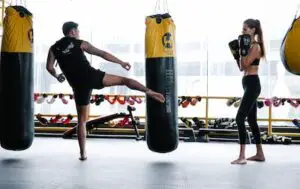As one of the most popular submission techniques in Jiu Jitsu, chokes are a crucial aspect of an athlete’s arsenal. Some of the most impressive victories have come from well-executed chokes, and mastering these moves can elevate any athlete’s game.
In this article, we will discuss the different types of Jiu Jitsu chokes, how to effectively utilize them in competition, and how to train properly to achieve success.
What are the different types of Jiu Jitsu chokes?
There are two main types of chokes in Jiu Jitsu: blood chokes and air chokes. Blood chokes target the carotid arteries, which are responsible for delivering blood to the brain. They restrict blood flow, which can lead to unconsciousness in a matter of seconds. Air chokes target the trachea, which is responsible for delivering air to the lungs. They cut off airflow, which can cause an opponent to pass out from lack of oxygen.
Blood chokes include the rear naked choke, the bow and arrow choke, and the arm triangle choke. Air chokes include the guillotine choke, the clock choke, and the loop choke.
How does a blood choke differ from an air choke?
A blood choke is a technique that is aimed at cutting off blood flow to the brain, while an air choke is used to cut off someone’s airflow. Both types of chokes can cause an opponent to pass out, but blood chokes are generally considered to be more effective. Blood chokes work by compressing the carotid arteries, which are responsible for providing blood to the brain. When blood flow is restricted in this way, an opponent will lose consciousness within a matter of seconds.
Air chokes are less effective because they do not target the carotid arteries directly. Instead, they are used to compress the trachea in order to cut off an opponent’s airflow. This can still cause an opponent to pass out, but it typically takes longer than a blood choke.
How do you properly execute a rear naked choke?
The rear naked choke is one of the most effective chokes in Jiu Jitsu, and it is used frequently in both competition and self-defense situations. To execute a rear naked choke, you should start by taking your opponent’s back. This can be done from a variety of positions, but one common way is to take the back from the turtle position.
Once you have your opponent’s back, you should secure your grip around their neck with one arm. This arm should be positioned across their neck, with your bicep on one side and your forearm on the other. Your other arm should be used to lock in the choke by securing the wrist of your choking hand.
To finish the choke, you should squeeze your arms together while driving your forearm into your opponent’s neck. This will cut off blood flow to the brain and cause your opponent to pass out within a matter of seconds.
What are the best setups for a guillotine choke?
The guillotine choke is a common air choke that is used frequently in Jiu Jitsu and MMA. It can be executed from a variety of positions, but some of the best setups include:
– From the front headlock position
– From the half guard position
– From the butterfly guard position
To execute a guillotine choke, you should start by securing your grip around your opponent’s neck with your arms. Your bicep should be on one side of their neck, while your forearm should be on the other. Your other arm should be used to lock in the choke by securing your choking hand’s wrist.
To finish the choke, you should squeeze your arms together while driving your forearm into your opponent’s trachea. This will cut off their airflow and cause them to pass out within a matter of seconds.
What is the difference between a clock choke and a loop choke?
The clock choke and the loop choke are two similar chokes that target an opponent’s airways. The clock choke is executed by wrapping one arm around an opponent’s neck, while the other arm is used to grab their opposite lapel. The choke is then finished by twisting the lapel like the hands of a clock, which compresses the trachea and cuts off an opponent’s airflow.
The loop choke is executed by trapping an opponent’s arm with one arm, while the other arm is used to loop behind their neck. The choke is then finished by pulling up on the trapped arm, which causes the looped arm to compress the trachea and cut off an opponent’s airflow.
How do you train to perfect your choke techniques?
To perfect your choke techniques, there are a few key things you can do:
– Drill your techniques regularly. Repetition is key to mastering any technique, and chokes are no exception. Make sure to drill your chokes regularly during training sessions.
– Practice on a variety of opponents. Chokes can vary in effectiveness depending on an opponent’s size, strength, and skill level. Make sure to practice your chokes on a variety of opponents to get a better understanding of their effectiveness.
– Study videos and instructional materials. There are a wealth of instructional materials available online and in print that can help you improve your choke techniques. Spend time studying these materials and incorporating new techniques into your training.
– Work on your grip strength. Chokes rely heavily on grip strength, so make sure to work on this area of your training. Grip strengthening exercises like rope climbs and farmer’s carries can be especially helpful in improving your grip strength.
Conclusion
In conclusion, the world of Jiu Jitsu offers a wide range of chokes that are both effective and diverse in their applications. From the basic rear naked choke to the intricate lapel chokes and the ever-impressive triangle choke, each technique brings its own unique set of challenges and opportunities. The various types of Jiu Jitsu chokes cater to different body positions, grips, and strategic approaches, allowing practitioners to develop a versatile arsenal of submissions. Whether you prefer gi or no-gi Jiu Jitsu, there are chokes suited for every situation, ensuring that practitioners can adapt and excel in their grappling journey. Mastering the different types of Jiu Jitsu chokes not only enhances one’s technical skills but also deepens their understanding of leverage, timing, and submission tactics. Ultimately, by exploring and incorporating these techniques into their training, practitioners can further elevate their Jiu Jitsu game and achieve success on the mat.





